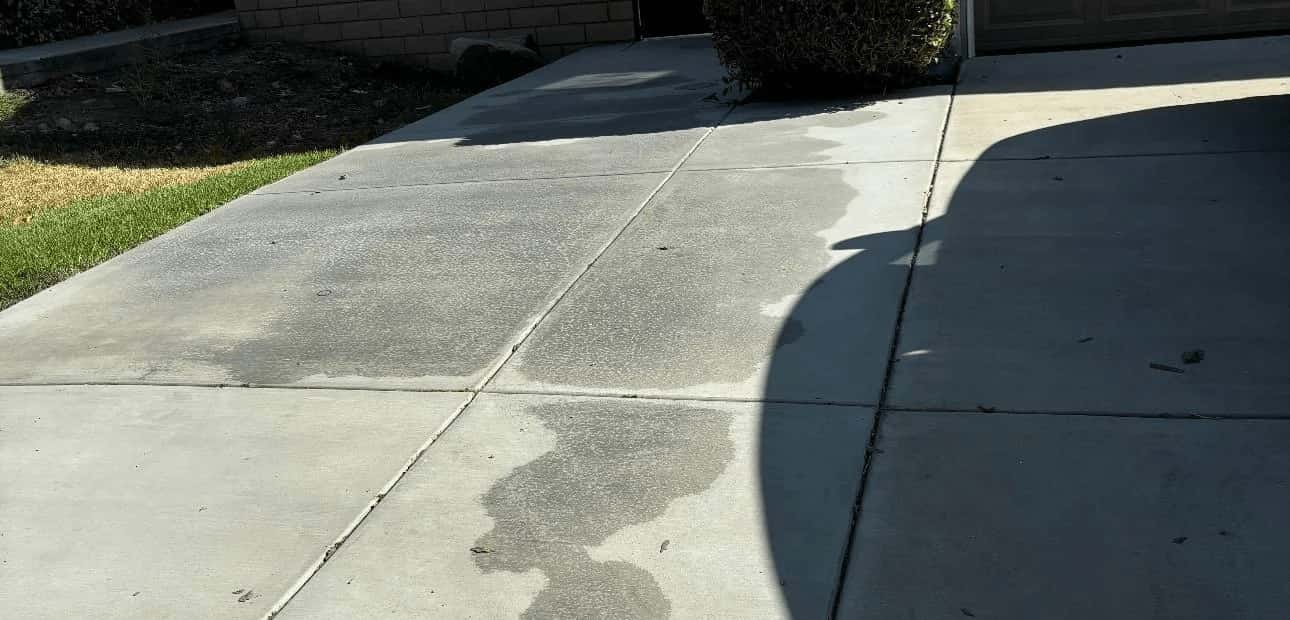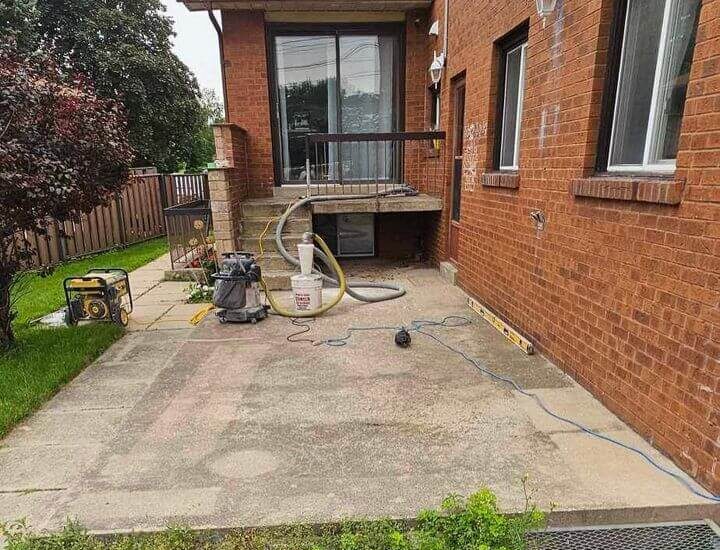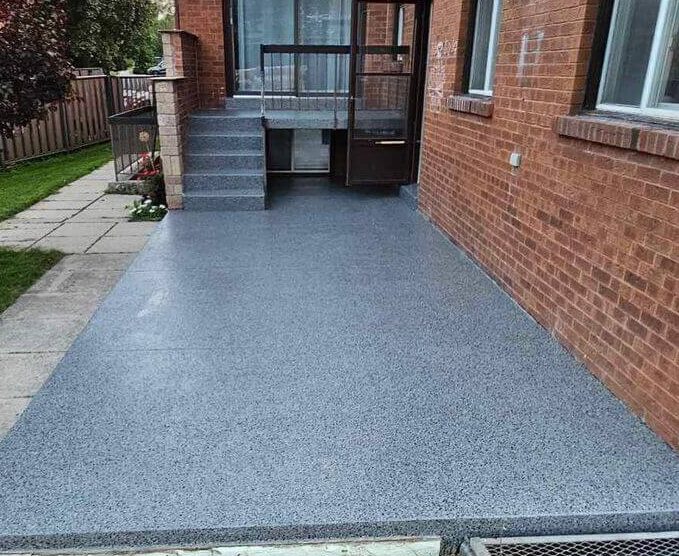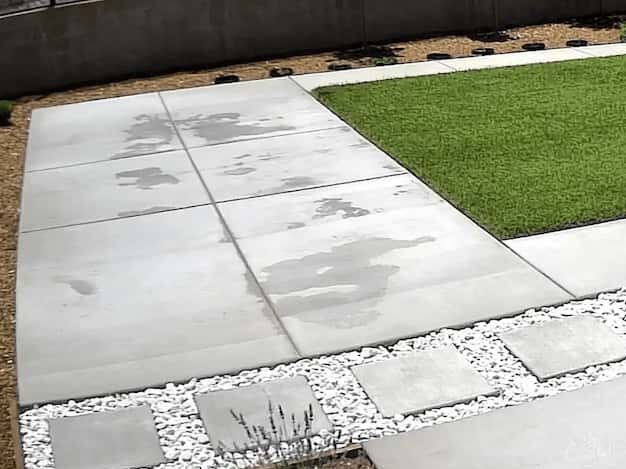You are Here: BLOG / HOW TO REMOVE WATER STAINS & DISCOLOURATION FROM NEWLY POURED CONCRETE
How to Remove Water Stains & Discolouration from Newly Poured Concrete
By TorontoConcreteRepairs on September 10, 2024

Concrete floors are known for their durability, low maintenance, and versatility. However, homeowners and builders occasionally notice dark wet spots on newly installed concrete floors. These spots can be both unsightly and concerning, especially when the concrete is fresh.
Removing them requires a deep understanding of what causes them and how to address the underlying issues effectively. In this guide, we’ll explore how to remove dark wet spots from new concrete floors, using proven methods from industry experts and resources.
What Causes Dark Wet Spots on New Concrete Floors?
Before jumping into removal techniques, it’s important to understand why dark wet spots appear in the first place.
Excess Moisture During Curing: New concrete contains a significant amount of water. During the curing process, moisture evaporates gradually, but if the moisture doesn’t escape evenly or at a consistent rate, it can lead to dark patches. According to Concrete Network, uneven curing is one of the most common reasons for discoloration on concrete surfaces.
Inadequate Ventilation: Moisture in concrete needs to evaporate properly, which is why poor ventilation in indoor or covered spaces can lead to wet spots that seem to linger.
Efflorescence: This occurs when water inside the concrete migrates to the surface and evaporates, leaving behind mineral salts. Efflorescence can sometimes cause discoloration or leave behind dark wet spots.
High Humidity: High humidity levels slow down the evaporation process, which can also contribute to dark, damp spots on the surface of the concrete.
Sealing Too Early: Sealing concrete too soon after installation can trap moisture inside, causing wet spots that last long after the concrete has cured.
RECENT POSTS
- Porch Makeover Ideas for Toronto Homes: Concrete Solutions for Curb Appeal
- What Is The Difference Between Concrete Resurfacing And Concrete Overlay?
- New Concrete Driveway Installation: A Successful Project by Toronto Concrete Repair Inc.
- How to Remove Water Stains & Discolouration from Newly Poured Concrete
- Concrete Resurfacing Pros and Cons
- Concrete Resurfacer vs Self-Leveling: Which Is Right for Your Project?
- Concrete Resurfacing vs Replacement: Which Option is Best for You?
- Concrete Repair vs. Replacement: A Comprehensive Guide
Book a FREE Consultation Call
Step-by-Step Guide to Removing Dark Wet Spots from Concrete Floors
Once you understand the root causes of the problem, you can apply the appropriate techniques to remove dark wet spots. Here’s a step-by-step process:
1. Identify and Diagnose the Problem
Before attempting any removal process, ensure you know whether you’re dealing with trapped moisture, efflorescence, or uneven curing. The solution will differ based on the cause. According to The Concrete Institute, diagnosing moisture-related issues early is key to long-term results. You can often spot efflorescence by its white, powdery appearance. Dark wet spots caused by trapped moisture will look damp even after significant drying periods.
2. Improve Ventilation and Airflow
Improper ventilation can trap moisture inside the concrete, preventing it from drying fully. Start by improving airflow in the affected areas. Open windows, use fans, or invest in a dehumidifier to accelerate the drying process. A professional recommendation from Build It magazine suggests maintaining a consistent temperature of around 60-80 degrees Fahrenheit for optimal moisture evaporation.
3. Dry the Concrete Thoroughly
For dark wet spots caused by excess moisture, drying is the most straightforward approach. Use industrial fans or blowers to speed up the process. You can also use heaters to raise the temperature and promote faster drying. According to a popular discussion on The Contractor’s Forum, some experts suggest waiting several days while monitoring the moisture levels with a concrete moisture meter.
4. Use a Concrete Cleaner
If the dark wet spots result from stains or efflorescence, a specialized concrete cleaner can help. Cleaners containing mild acidic compounds like vinegar or store-bought concrete cleaners can dissolve the salts left by efflorescence and remove stains. Make sure to follow the manufacturer’s instructions carefully. For efflorescence, many contractors recommend using a cleaner with hydrochloric acid, but be cautious and use protective gear when handling such chemicals.
5. Resurfacing the Concrete
In some cases, dark wet spots may not respond to basic drying or cleaning methods. For severe discoloration, resurfacing may be the best option. Resurfacing involves applying a thin layer of new concrete over the existing surface, which covers stains and dark patches. Products like polymer-modified overlays offer a durable and attractive solution, blending seamlessly with the original concrete.


6. Seal the Concrete Properly
After the spots are cleaned or resurfaced, sealing the concrete helps protect it from future moisture-related issues. Ensure that the concrete is fully dry before sealing. Use a high-quality, breathable sealer designed for concrete, allowing any residual moisture to escape while protecting the surface. The American Concrete Institute advises against using non-breathable sealers on new concrete, as this can trap moisture and cause future discoloration.
7. Monitor for Recurrence
Even after cleaning and sealing, it’s essential to monitor the floor to ensure the issue doesn’t recur. Check for signs of new dark spots and act promptly if they reappear. Regular maintenance, including proper ventilation and cleaning, will help extend the life of your concrete floor.
Expert Tips for Long-Lasting Results
To ensure success when removing dark wet spots from new concrete, consider these expert tips gathered from industry professionals:
Use a Moisture Barrier: Install a vapor barrier during the initial concrete pour to prevent ground moisture from seeping into the concrete. Concrete Construction Magazine suggests using a polyethylene sheet below the slab for optimal moisture control.
Test for Moisture Before Sealing: Always test the moisture content in your concrete using a moisture meter before applying any sealer. This ensures the concrete is dry enough to be sealed without trapping moisture inside.
Eco-Friendly Cleaners: Consider using environmentally friendly cleaning solutions, especially in residential spaces. Many contractors on Concrete Network’s Forums recommend low-VOC products to reduce environmental impact.
What Causes Dark Wet Spots on New Concrete Floors?
When attempting to remove dark wet spots from concrete, it’s crucial to avoid these common mistakes:
Sealing Too Soon: As mentioned earlier, sealing wet concrete can trap moisture and cause long-term issues. Wait until the surface is fully dry before sealing.
Using Harsh Chemicals: Avoid overly abrasive cleaners that could damage the surface of the concrete. Always follow the manufacturer’s recommendations when selecting cleaning solutions.
Ignoring the Cause: Simply cleaning dark wet spots without addressing the root cause can lead to recurring issues. Make sure to investigate and fix underlying moisture problems before sealing or resurfacing.

Conclusion
Dark wet spots on new concrete floors can be an eyesore, but with the right approach, they can be effectively removed. Whether it’s through improved ventilation, drying techniques, or the application of concrete cleaners, addressing the underlying cause of the wet spots is crucial. For severe cases, resurfacing and sealing offer long-lasting solutions.
Hiring professionals who specialize in concrete cleaning & sealing can also ensure optimal results. These experts have the experience and tools necessary to diagnose the issue and provide customized solutions. By following these steps and best practices, you’ll achieve a flawless and long-lasting concrete surface.
If you still have any problem, you can reach out to us, our experts will help in solving the issue, you can call our team and discuss your issues, we offer FREE CONSULTATION & INSPECTION, we are happy to assist you.
